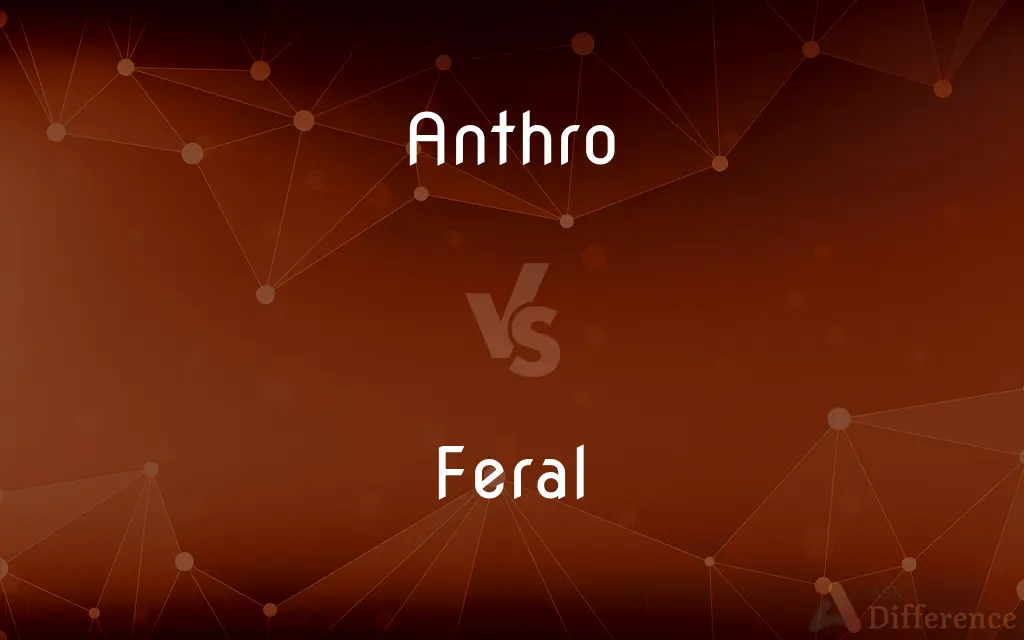Anthro vs. Feral — What's the Difference?
By Maham Liaqat & Urooj Arif — Updated on March 19, 2024
Anthro characters are anthropomorphic, blending human traits with animal features, while feral refers to animals or characters with wild, untamed characteristics, lacking human traits.

Difference Between Anthro and Feral
Table of Contents
ADVERTISEMENT
Key Differences
Anthro, short for anthropomorphic, describes characters or entities that blend human characteristics with those of animals. These characters often walk on two legs, possess human intelligence, and may wear clothing or use tools. Feral, in contrast, refers to animals or characters that retain their natural, wild state. They exhibit behaviors and appearances typical of their species without anthropomorphic attributes, such as walking on four legs and lacking human-like intelligence or emotional expressions.
Anthro characters are commonly found in various forms of media, including cartoons, video games, and literature, where they serve to explore complex themes through the lens of humanized animals. Feral characters or animals, on the other hand, are often depicted in their natural environments, focusing on their instincts, survival, and interactions within their ecosystem. While anthro characters can express a wide range of human emotions and thoughts, feral ones are usually limited to more basic, instinct-driven behaviors.
In terms of design, anthro characters may feature exaggerated animal traits combined with human physique and facial expressions, enabling them to convey emotions and perform actions in a human-like manner. Feral animals or characters are designed to closely resemble their real-world counterparts, emphasizing authenticity and adherence to the animal's natural form and behavior.
The portrayal of anthro and feral characters can significantly impact storytelling. Anthro characters allow for the exploration of human societal issues, ethics, and personal identity through a unique, often more relatable lens. Feral characters, however, are typically used to explore themes of nature, instinct, and the raw essence of survival, often presenting a contrast to human civilization and its complexities.
Culturally, anthro characters have given rise to specific fandoms and subcultures, where enthusiasts appreciate and create anthropomorphic art and stories, sometimes identifying with or ascribing unique identities to these characters. The appreciation for feral animals or characters, while widespread, is generally rooted in an interest in wildlife, conservation, and the beauty of the natural world, without the same level of personal identification or fandom culture associated with anthro characters.
ADVERTISEMENT
Comparison Chart
Definition
Characters with human and animal traits.
Animals or characters in a wild, untamed state.
Physical Appearance
Human-like body structure, often upright, with animal features.
Typical animal appearance, without human traits.
Intelligence/Behavior
Human-level intelligence and emotions.
Natural animal instincts and behaviors.
Role in Media
Explores human themes through anthropomorphic lens.
Focuses on natural instincts and survival.
Cultural Impact
Has dedicated fandoms and subcultures.
Appreciated for wildlife and conservation interests.
Compare with Definitions
Anthro
Capable of a wide range of human-like emotions and facial expressions.
The anthro fox showed expressions of joy, sadness, and anger throughout the story.
Feral
Interactions are based on natural instincts and animal hierarchy rather than complex societies.
The feral elephants formed a close-knit matriarchal group for protection and foraging.
Anthro
Characters that blend human and animal characteristics, often in creative media.
Mickey Mouse is an iconic anthro character with human intelligence and animal features.
Feral
Often subjects of wildlife conservation efforts and educational materials.
Feral species are often the focus of conservation campaigns to protect natural habitats.
Anthro
Walks upright, displays human intelligence, and often engages in human activities.
The anthro character in the novel wore clothing and used technology just like humans.
Feral
Animals or characters exhibiting wild, untamed characteristics, true to their natural behavior.
The documentary featured a feral wolf pack roaming the wilderness.
Anthro
Engages in complex social interactions and societies similar to humans.
In the animated series, anthro animals lived in a structured society with laws and culture.
Feral
Moves and behaves according to its species' natural instincts, often on all fours.
The feral cat hunted and lived independently, avoiding human contact.
Anthro
Forms the basis of various fandoms and artistic communities.
Anthro characters are celebrated annually at conventions attended by fans worldwide.
Feral
Displays emotions through natural behaviors rather than human-like expressions.
The feral dog's trust was slowly earned through its cautious approach and eventual acceptance.
Anthro
Short for anthropology
You have so many undergrads who go try out fieldwork and don't pursue careers in anthro
An anthro degree
Feral
A feral animal or plant (from Latin: fera, 'a wild beast') is one that lives in the wild but is descended from domesticated specimens. As with an introduced species, the introduction of feral animals or plants to non-native regions may disrupt ecosystems and has, in some cases, contributed to extinction of indigenous species.
Anthro
Anthropology.
Feral
Having returned to an untamed state from domestication
A pack of feral dogs.
Anthro
An anthropologist.
Feral
Existing in a wild or untamed state.
Anthro
An anthropomorphic character.
Feral
Of or suggestive of a wild animal; savage
A feral grin.
Anthro
(informal) anthropomorphic
Feral
Wild, untamed.
Feral
Of an animal, being wild but descended from domestic or captive animals.
Feral
(of a person) Contemptible, unruly, misbehaved.
Feral
Of or pertaining to the dead, funereal.
Feral
A domesticated animal that has returned to the wild; an animal, particularly a domesticated animal, living independently of humans.
Feral
A contemptible young person, a lout, a person who behaves wildly.
Feral
A person who has isolated themselves from the outside world; one living an alternative lifestyle.
Feral
A character in furry art or literature which has the physical characteristics (body) of a regular animal (typically quadripedal), that may or may not be able to communicate with humans or anthros (contrasts anthro)
The story is about a group of ferals which have to explore the ruins of society after the humans die out.
Feral
Wild; untamed; ferine; not domesticated; - said of beasts, birds, and plants.
Feral
Funereal; deadly; fatal; dangerous.
Feral
Wild and menacing;
A ferocious dog
Common Curiosities
Can feral animals become domesticated?
Yes, with time and effort, some feral animals can be domesticated or acclimated to human presence, but they may retain wild instincts.
What is the purpose of portraying animals as feral?
Portraying animals as feral emphasizes their natural, untamed state, highlighting instinctual behaviors and survival in the wild.
What themes do feral characters explore?
Feral characters often explore themes related to nature, instinct, survival, and the contrast between the wild and human civilization.
Can anthro characters be found in all types of media?
Yes, anthro characters appear across various media, including cartoons, video games, literature, and art.
Are anthro characters considered human?
No, anthro characters are not considered human; they are fictional representations that blend human qualities with animal features.
Do feral animals always live in the wild?
Feral animals typically live in the wild, but some may reside in urban areas, adapting to environments outside their natural habitat.
How do anthro characters differ from traditional animal characters?
Anthro characters have human-like intelligence and behaviors, while traditional animal characters are portrayed more realistically according to their species.
What does "anthro" stand for?
"Anthro" stands for anthropomorphic, referring to characters that combine human and animal traits.
Why are anthro characters popular in fandoms?
Anthro characters are popular for their unique blend of human and animal traits, offering creative and relatable perspectives on human experiences.
Are there ethical considerations in depicting feral animals?
Ethical considerations may include ensuring accurate and respectful representation, especially in educational materials or conservation efforts.
Share Your Discovery

Previous Comparison
Monologue vs. Speech
Next Comparison
Plumbago vs. GraphiteAuthor Spotlight
Written by
Maham LiaqatCo-written by
Urooj ArifUrooj is a skilled content writer at Ask Difference, known for her exceptional ability to simplify complex topics into engaging and informative content. With a passion for research and a flair for clear, concise writing, she consistently delivers articles that resonate with our diverse audience.














































